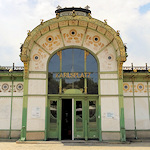
Some of the best Art Nouveau (Jugendstil) architecture in Vienna appears in the most unlikely places. Like railway stations.
Forget about drab, functional, concrete monstrosities. Step forward Otto Wagner and his twin “Pavillon” station entrances at Karlsplatz.
- Built around 1900 for the new Stadtbahn urban railway
- Famous Jugendstil design in apple green, gold, and white
- Now a small, permanent Otto Wagner exhibition
- Generally only open in the warmer months
- See also:
- Otto Wagner locations
- Free one-time entry with the Vienna Pass
Pavilion Background
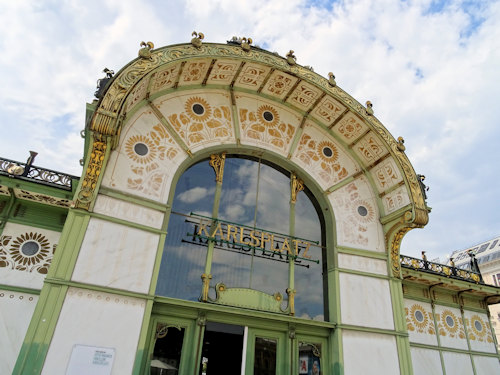
(The gold-patterned entranceway)
As 19th-century Vienna anticipated growing ever bigger and more important, the authorities decided it was high time to build a modern metropolitan railway to allow mass transit and link up the rail routes into the city.
Things didn’t work out quite to plan (cough, WWI, cough, end of the empire, cough).
Still, the late 1890s saw the opening of various “Stadtbahn” city rail lines. Otto Wagner designed the new stations, bridges, railings, etc., and many of these buildings and structures remain in use today in all their renovated Jugendstil glory.
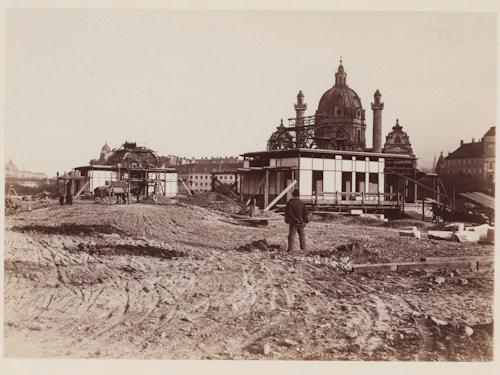
(The two station buildings during their construction, photographed by Friedrich Strauß in 1899; Wien Museum Inv.-Nr. 94600/412/2; excerpt reproduced with permission under the terms of the CC0 licence)
The two station pavilions at Karlsplatz no longer lead onto the platform but remain perhaps the most striking examples of Wagner’s railway architecture. The east one is a café, but the west one is a fully-refurbished exhibition hall run by the Wien Museum.
What can you see?
The outsides feature the distinctive apple green and white colours typical across the Stadtbahn.
However, the Karlsplatz pavilions stand out from their colleagues because of the golden sunflower motif and decorated entrance arch.
(Photo tip: um, wait until the sun shines directly on the façade)
The renovated west pavilion really is a work of art, particularly when the full sun brings out the shine in the gold. This despite the graffiti that seems to appear at intervals in a seemingly never-ending game of catch up with the cleaning crews.
Inside, the colour scheme continues, and you might recognise the checkered floor tiling from other working stations across the city.
The Otto Wagner exhibition is cosy, occupying just three small rooms off the entrance hall, together with a mini shop. So you can get around it quickly. (All information in posters and labels was provided in English and German on my visit.)
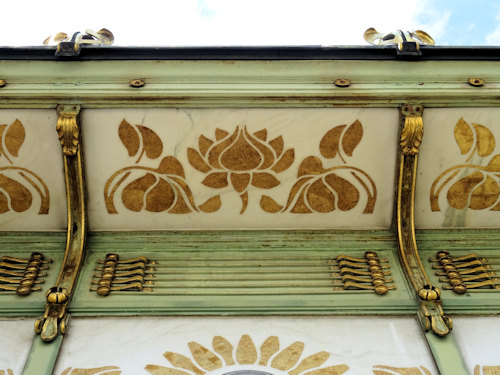
(Close up of the decoration under the eaves)
The displays guide you through various aspects of Wagner’s work and life.
So you see, for example, photos and drawings of the Stadtbahn stations at the time of their opening, designs and photos of his other great works (some since destroyed), a model of his famous Steinhof Kirche, a biographical timeline, and portraits.
All of it aptly communicates Wagner’s progressive understanding of urban development.
My highlights:
- Photos of some of the houses when first constructed – astonishing how much less cluttered the residential streets seem to be
- His vision for the Karlsplatz area (never implemented)
- Drawings of wonderful buildings that never got built, like his designs for the Wien Museum and a Karlsplatz department store
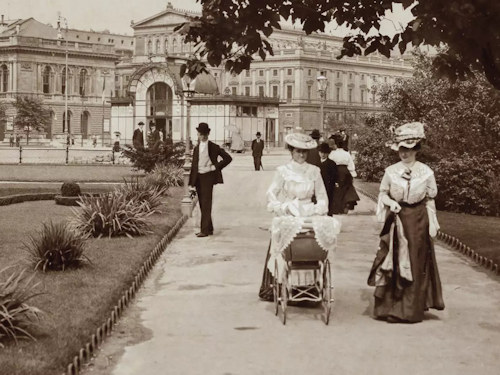
(Women walking on Karlsplatz square with one of the pavilions in the background. Photographed around 1910 by Martin Gerlach sen. and reproduced by C. Angerer & Göschl; Wien Museum Inv.-Nr. 225086; excerpt reproduced with permission under the terms of the CC0 licence)
Great as Wagner’s achievements were, you get the feeling he might have been a tad frustrated, based on the gap between his vision and what was actually done. Or maybe that’s just the fate of any architect and planner.
It seems he also craved (deserved?) more than just the one Imperial commission (for the Hofpavillon at Hietzing), given the various proposals and designs that combined artistic merit, his renowned wish for functionality, and clear statements of imperial greatness.
Tickets & visitor tips
At the time of writing, adult tickets cost €5 with concessions or you can peruse the exhibition once for free if you have a Vienna Pass (see a review).
The shop had posters, postcards and books covering Viennese art around 1900, including the likes of Wagner (surprise), Loos, Hoffman, Klimt and Jugendstil in general. You might also find some fine glassware, jewellery and crockery on sale from local artists and designers.
Some tips:
- It only takes a few minutes to slip around the exhibition and take a look at the insides of this iconic building, so no need to set aside too much time for it
- Karlsplatz is not far from another of Otto Wagner’s more famous designs, the Majolika House (see the map below)
- On the way to the Majolika House, take a peek at the Jugendstil Secession building that houses Gustav Klimt’s Beethoven Frieze
- The parent museum (the Wien Museum) is also on Karlsplatz
- In the weeks leading up to Christmas, this raised area offers lovely little views (if I remember correctly) after dusk across to the lit-up Karlskirche with the twinkling lights of the Art Advent Christmas market in front of it
How to get to the pavilion
One of the advantages of a railway station building as a tourist attraction is that it’s quite close to, well, a railway station. It’s right on top of Karlsplatz, a huge city transport hub. Any of these lines get you there:
- U1, U2 and U4 subway
- Trams 1, 62, 2, D and 71 to the Karlsplatz or Karlsplatz/Oper stop
- Buses 4A, 2A and 59A to the Karlsplatz or Karlsplatz/Oper stop
If you can’t see the pavilion from where you’re dropped, simply go into the subway station and look for the Resselpark exit. Follow the path outside that curves up and to the left.
Alternatively, a direct exit leads there from the U4 subway platform. Go up the stairs at the east end, and then take the stairs on the left that lead back in the other direction. You pop out behind the pavilion.
Address: Karlsplatz, 1040 Vienna | Website
